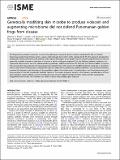Genetically modifying skin microbe to produce violacein and augmenting microbiome did not defend Panamanian golden frogs from disease
Author(s)
Becker, Matthew H; Brophy, Jennifer AN; Barrett, Kevin; Bronikowski, Ed; Evans, Matthew; Glassey, Emerson; Kaganer, Alyssa W; Klocke, Blake; Lassiter, Elliot; Meyer, Adam J; Muletz-Wolz, Carly R; Fleischer, Robert C; Voigt, Christopher A; Gratwicke, Brian; ... Show more Show less
DownloadPublished version (2.836Mb)
Publisher with Creative Commons License
Publisher with Creative Commons License
Creative Commons Attribution
Terms of use
Metadata
Show full item recordAbstract
We designed two probiotic treatments to control chytridiomycosis caused by Batrachochytrium dendrobatidis (Bd) on infected Panamanian golden frogs (Atelopus zeteki), a species that is thought to be extinct in the wild due to Bd. The first approach disrupted the existing skin microbe community with antibiotics then exposed the frogs to a core golden frog skin microbe (Diaphorobacter sp.) that we genetically modified to produce high titers of violacein, a known antifungal compound. One day following probiotic treatment, the engineered Diaphorobacter and the violacein-producing pathway could be detected on the frogs but the treatment failed to improve frog survival when exposed to Bd. The second approach exposed frogs to the genetically modified bacterium mixed into a consortium with six other known anti-Bd bacteria isolated from captive A. zeteki, with no preliminary antibiotic treatment. The consortium treatment increased the frequency and abundance of three probiotic isolates (Janthinobacterium, Chryseobacterium, and Stenotrophomonas) and these persisted on the skin 4 weeks after probiotic treatment. There was a temporary increase in the frequency and abundance of three other probiotics isolates (Masillia, Serratia, and Pseudomonas) and the engineered Diaphorobacter isolate, but they subsequently disappeared from the skin. This treatment also failed to reduce frog mortality upon exposure.
Date issued
2021Department
Massachusetts Institute of Technology. Department of Biological EngineeringJournal
ISME Communications
Publisher
Springer Science and Business Media LLC
Citation
Becker, Matthew H, Brophy, Jennifer AN, Barrett, Kevin, Bronikowski, Ed, Evans, Matthew et al. 2021. "Genetically modifying skin microbe to produce violacein and augmenting microbiome did not defend Panamanian golden frogs from disease." ISME Communications, 1 (1).
Version: Final published version